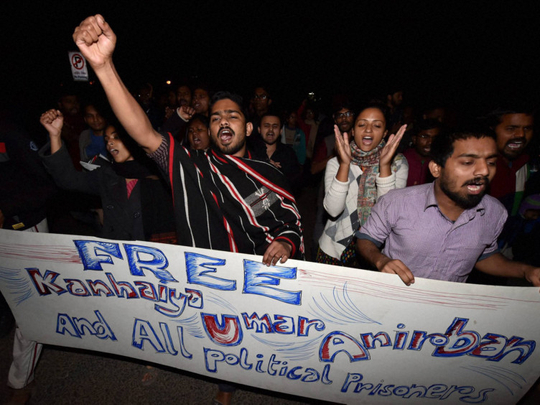
Last week, a tragic farce overwhelmed India just as Prime Minister Narendra Modi was promoting his ambitious “Make in India” programme to spur domestic manufacturing. It began with Zee News, a jingoistic and vastly influential television channel, whose owner had openly campaigned for Modi’s election in 2014. Zee broadcast an amateur video that showed students at the prestigious Jawaharlal Nehru University (JNU) shouting slogans in favour of Kashmir’s independence and against the 2013 execution of Afzal Guru, a Kashmiri accused of attacking the Indian parliament in 2001.
Some other ultra-patriotic channels picked up Zee’s accusatory refrain against JNU students: that they were “anti-national”. Modi’s home minister declared his resolve not to “spare” the culprits. His education minister tweeted her angry refusal to tolerate any “insult to Mother India”. Delhi police raided the university campus. They arrested, among others, the president of the student union and a former teacher, charging them with sedition no less.
The home minister quoted a tweet supporting JNU students by Hafiz Saeed, a notorious Pakistani militant, to accuse them of links with evildoers. Incensed by the insults to Mother India, a mob of politicians and pro-Modi lawyers at a Delhi court beat up journalists as well as JNU students, including the one accused of treason.
Soon after these extraordinary events it emerged that not only did Saeed’s supposed endorsement come from a parody Twitter account, but the original video of sloganeering students had also been doctored. An avalanche of scorn has landed on the Modi government and its seedy partisans in the Indian media. Adverse international headlines have made “Fake in India” and “Hate in India” seem more plausible ventures than Make in India for now.
A government driven hither and thither by Twitter burlesque is guilty of abysmal ineptitude. But frenzied deception and self-deception over Kashmir are not unique to Hindu nationalists. Rather, unreason on Kashmir is the original sin of Indian nationalism, secular as well as hardline Hindu.
Tens of thousands have died during more than two decades of a vicious Pakistan-backed insurgency and counter-insurgency in Indian-ruled Kashmir; an unknown number have been tortured or “disappeared”. The violence drove away an entire community of Kashmiri Hindus from the valley where most of the state’s population lives. During this time, the political and popular mood has progressively hardened in India. The extravagant middle-class fantasy of a “Global Indian Takeover” made local Kashmiri disaffection seem a trifling irritant .
Questionable rule
Many journalists covering Kashmir turned into willing dupes for Indian intelligence agencies. Even liberal-left commentators, eloquent in their denunciation of the Israeli treatment of Palestinian Arabs, turned coyly evasive, or kept strategically quiet, on the subject of India’s morally questionable rule over Kashmir. Many of those trying to write about brutality and rage in Kashmir were also stigmatised as “anti-national”. Hyper-patriotism on this issue helped a whole generation of television anchors and columnists rise to fame while screaming for the blood of seditionists.
Cynically hoping to exploit this mood, the Congress government led by Manmohan Singh executed Afzal Guru in the run-up to parliamentary elections in 2014. As Amnesty International pointed out, Guru, denied a fair trial, had been sentenced to death on shockingly flimsy circumstantial evidence. While partly admitting this, the Supreme Court still ordered that “his life should become extinct” since the “collective conscience of the society” had to be “satisfied”.
Guru was not allowed even the doomed man’s customary last meeting with his relatives before he was rushed to the gallows early one morning. Burying him in an unmarked grave, the government then imposed a curfew on the valley of Kashmir that lasted for weeks. Despite, or perhaps because of the Congress government’s crude attempts to prevent it, Guru became a martyr in the eyes of a new generation of Kashmiris.
Kashmiri Muslims remain as disaffected as ever — and with good reason. A few hours before the assault on JNU last week, Indian security forces shot dead two Kashmiri students in the valley. The Indian media barely noticed just another day of impunity in Kashmir. Neither such routine killings, nor the endless crackdowns and curfews have changed or will change Kashmir’s ground realities. But last week’s multi-pronged assaults on JNU students revealed how profoundly and extensively a sustained lynch-mob hysteria over Kashmir had damaged Indian institutions — security agencies and the legal system, as well as the media and the larger public sphere — long before Modi’s ascent to power. In this sense, a long, savage but largely invisible war on India’s margins is finally coming home.
— Bloomberg
Pankaj Mishra is a Bloomberg View columnist, author and commentator.










